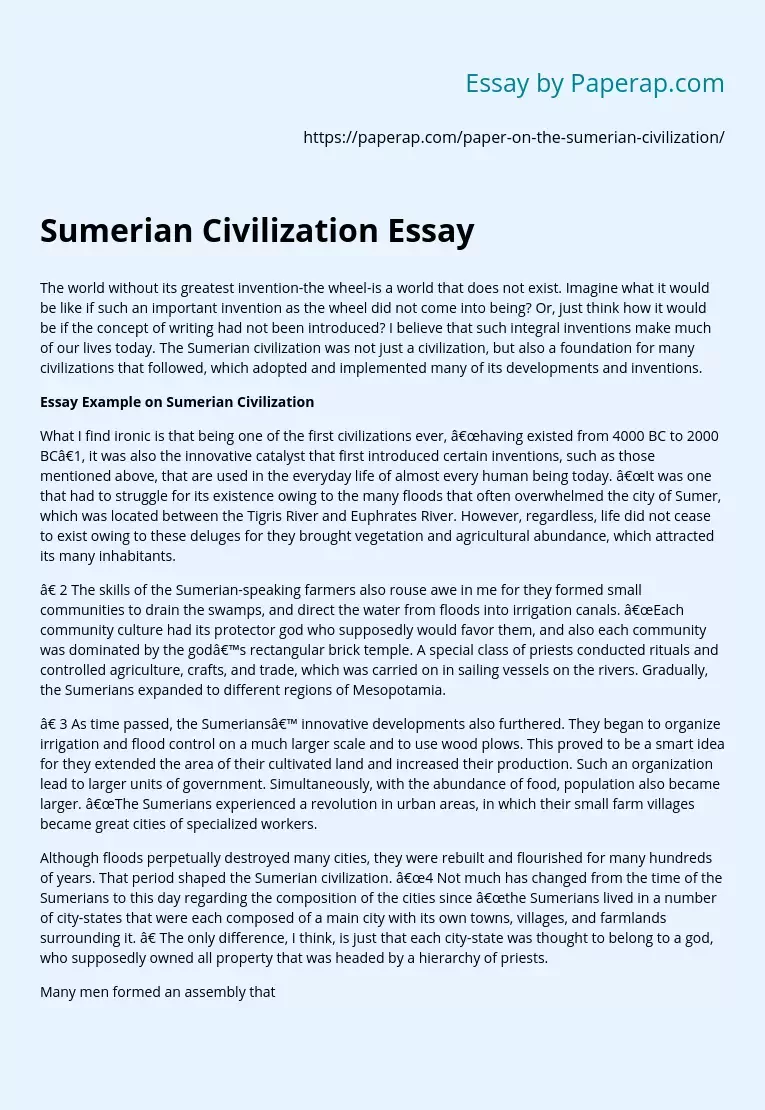Sumerian Civilization Essay
The world without its greatest invention-the wheel-is a world that does not exist. Imagine what it would be like if such an important invention as the wheel did not come into being? Or, just think how it would be if the concept of writing had not been introduced? I believe that such integral inventions make much of our lives today. The Sumerian civilization was not just a civilization, but also a foundation for many civilizations that followed, which adopted and implemented many of its developments and inventions.
Essay Example on Sumerian Civilization
What I find ironic is that being one of the first civilizations ever, “having existed from 4000 BC to 2000 BC”1, it was also the innovative catalyst that first introduced certain inventions, such as those mentioned above, that are used in the everyday life of almost every human being today. “It was one that had to struggle for its existence owing to the many floods that often overwhelmed the city of Sumer, which was located between the Tigris River and Euphrates River.
However, regardless, life did not cease to exist owing to these deluges for they brought vegetation and agricultural abundance, which attracted its many inhabitants.
” 2 The skills of the Sumerian-speaking farmers also rouse awe in me for they formed small communities to drain the swamps, and direct the water from floods into irrigation canals. “Each community culture had its protector god who supposedly would favor them, and also each community was dominated by the god’s rectangular brick temple. A special class of priests conducted rituals and controlled agriculture, crafts, and trade, which was carried on in sailing vessels on the rivers.
Gradually, the Sumerians expanded to different regions of Mesopotamia.
” 3 As time passed, the Sumerians’ innovative developments also furthered. They began to organize irrigation and flood control on a much larger scale and to use wood plows. This proved to be a smart idea for they extended the area of their cultivated land and increased their production. Such an organization lead to larger units of government. Simultaneously, with the abundance of food, population also became larger. “The Sumerians experienced a revolution in urban areas, in which their small farm villages became great cities of specialized workers.
Although floods perpetually destroyed many cities, they were rebuilt and flourished for many hundreds of years. That period shaped the Sumerian civilization. “4 Not much has changed from the time of the Sumerians to this day regarding the composition of the cities since “the Sumerians lived in a number of city-states that were each composed of a main city with its own towns, villages, and farmlands surrounding it. ” The only difference, I think, is just that each city-state was thought to belong to a god, who supposedly owned all property that was headed by a hierarchy of priests.
Many men formed an assembly that conducted several local affairs. “The assembly was guided by a council of richer, older men. In times of crisis like war over water rights or against invaders, a powerful individual had command as a kind of temporary king. He might be the chief priest, a man chosen by the assembly, or one who took over power by military force. This temporary king was believed to be chosen by the city god to represent him. At different times different kings were recognized as lords of all of Sumer according to what was interpreted as the changing will of the gods. “5.
Sumerian Civilization Essay. (2019, Nov 27). Retrieved from https://paperap.com/paper-on-the-sumerian-civilization/

